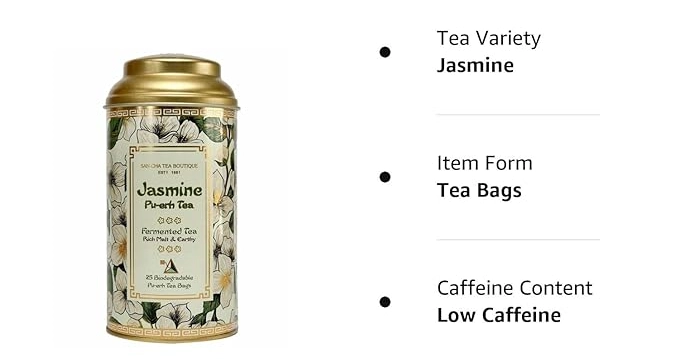Pu-erh Tea Review: Looking to expand your tea collection? Pu-erh tea might be just what you’re looking for. In this pu-erh tea review, we’ll explore the ins and outs of this unique tea, including its benefits, drawbacks, and what customers have to say about it. So, is pu-erh tea worth trying? Let’s find out.
About Pu-erh Tea
Originating from the lush, misty mountains of Yunnan province, pu-erh tea is a fermented delight that has captured the palates of tea connoisseurs across the globe. This tea stands out from its counterparts due to its unique processing method, involving microbial fermentation after the leaves have been dried and rolled. This process not only contributes to its distinctive earthy flavor but also enhances its longevity, with some aged pu-erh teas reaching venerable statuses among enthusiasts.
The history of pu-erh tea is as rich as its flavor, with its origins tracing back over a thousand years. It was traditionally compressed into cakes or bricks for ease of transport along ancient trade routes, a practice that continues today. This historical method of compression not only contributed to its unique shape but also played a role in the aging process, allowing the tea to develop a deeper, more complex flavor profile over time.
Pu-erh tea is categorized into two main types: raw (Sheng) and ripe (Shou). Raw pu-erh, the traditional form, undergoes a natural aging process that can span years or even decades, slowly developing its character. Ripe pu-erh, on the other hand, is a more modern innovation that hastens the aging process through controlled fermentation, offering a quicker path to a matured taste. Each type offers a unique tasting experience, from the fresh, lively notes of a young Sheng to the deep, mellow richness of an aged Shou, providing a spectrum of flavors for enthusiasts to explore.
Red Flags When Buying Pu-erh Tea
Navigating the world of pu-erh tea can be a rewarding journey for the tea enthusiast, but it’s essential to approach with caution to avoid falling prey to common pitfalls. The market for pu-erh tea is not immune to counterfeit operations, where unscrupulous vendors might sell inferior leaves as high-grade pu-erh. Knowing what to look for can save you both disappointment and money. Firstly, be wary of deals that seem too good to be true. Authentic, aged pu-erh tea commands a premium price due to its intricate processing and aging methods. Prices significantly lower than the market rate may indicate a lower quality product or, worse, a counterfeit.
Another red flag is the lack of detailed information about the tea’s origin, age, and processing methods. Reputable sellers are typically transparent about their product’s history and characteristics, understanding that such details are crucial to connoisseurs. Beware of sellers who cannot provide this information or who offer vague descriptions.
Lastly, the physical appearance of the tea can offer clues about its authenticity. Genuine pu-erh should be well-compressed and free of excessive dust or mold. The smell of the tea before brewing should be pleasant and not overly musty, a sign that it has been stored properly. By being vigilant for these red flags, you can enhance your chances of acquiring genuine, high-quality pu-erh tea that will truly enrich your tea experience.
Pros of Pu-erh Tea
The allure of pu-erh tea extends far beyond its intriguing fermentation process and historical significance. One of the most celebrated benefits is its potential to bolster health and wellness. Research indicates that regular consumption of pu-erh tea could have a favorable impact on metabolic health, including aiding in the management of cholesterol levels. This is particularly appealing in today’s health-conscious society where natural remedies are highly sought after. Moreover, pu-erh tea’s unique fermentation process is believed to foster beneficial gut bacteria, which plays a vital role in digestion and overall gut health.
In addition to its health-promoting properties, pu-erh tea offers a sensory experience unlike any other. Its flavor complexity is unparalleled, ranging from sweet and floral notes in younger teas to the deep, earthy undertones characteristic of its aged counterparts. This diversity in flavor profiles makes pu-erh tea a fascinating subject of exploration for enthusiasts and newcomers alike. The ritual of brewing pu-erh tea, with its traditional methods and tools, adds another layer of enjoyment, offering a moment of tranquility and mindfulness in the rush of daily life.
For those seeking a tea that combines rich cultural heritage with potential health benefits and an unmatched tasting journey, pu-erh tea presents a compelling choice. Its standing in the tea community as a beverage of depth and complexity is well-earned, inviting a deeper appreciation and understanding with every cup.
Cons of Pu-erh Tea
Despite its numerous attractions, pu-erh tea may not appeal to all. Its distinctive, sometimes robust flavor profile, while a highlight for some, can be off-putting to those accustomed to lighter teas. This divergence in taste preference underscores the subjective nature of tea enjoyment and suggests that pu-erh tea might not cater to everyone’s palate. Additionally, the cost of genuine, high-quality pu-erh tea, particularly those varieties that are aged, can pose a significant barrier for individuals interested in exploring this tea category. Such investment may deter casual tea drinkers or those on a tight budget from experiencing what pu-erh has to offer.
Potential health concerns also exist with pu-erh tea consumption. While many enjoy pu-erh tea without issue, some individuals might find it triggers digestive discomfort, a factor that could be linked to its fermentation process. Others may need to be cautious of its caffeine content, which, depending on the brew’s strength and individual sensitivity, could lead to jitters or disrupt sleep patterns. These aspects of pu-erh tea, while not detracting from its rich cultural heritage and the enjoyment it brings to many, highlight the importance of considering personal health, taste preferences, and financial willingness when deciding to venture into the world of pu-erh tea.
Reviews By Customers
Customer feedback on pu-erh tea showcases a broad spectrum of experiences and opinions. Enthusiasts of pu-erh tea frequently commend its distinct taste and the unique energy boost it provides, with some noting a marked improvement in focus and alertness. There are individuals who advocate for its weight management properties, attributing a feeling of fullness and decreased appetite to their regular consumption of this fermented tea. On the flip side, not all reviews are glowing. A portion of drinkers find the robust, earthy flavors of pu-erh to be an acquired taste, one that doesn’t always align with their preferences, especially if they lean towards lighter, more traditional teas. Others have reported discomfort, such as an unsettled stomach, which they suspect may be related to the tea’s fermentation process or its caffeine content. It’s also worth noting that experiences with pu-erh tea can vary widely based on the specific type (raw vs. ripe), the quality of the tea, and individual taste buds and digestive systems. These reviews underline the diversity of pu-erh tea’s impact on its consumers, emphasizing the importance of personal experimentation to truly gauge its suitability for one’s palette and wellness routine.
Is It Legit Or Scam?
The authenticity of pu-erh tea is a topic of significant importance for enthusiasts and newcomers alike. The world of pu-erh tea is, for the most part, filled with genuine products that boast a rich history and a dedicated fan base. However, due to its popularity and the high value placed on aged varieties, the market has also seen the emergence of counterfeit pu-erh teas. These knock-offs are often marketed to mimic high-grade pu-erh, misleading consumers with subpar leaves at inflated prices. The legitimacy of pu-erh tea itself isn’t in question, but potential buyers should exercise caution and due diligence when purchasing.
Engaging with reputable dealers who have established credibility in the tea community is a crucial step in ensuring the pu-erh tea you buy is authentic. Many respected vendors provide detailed information about their pu-erh tea’s origin, processing techniques, and age, which can serve as indicators of the tea’s authenticity. Additionally, certification marks and reviews from other tea enthusiasts can offer further assurance of a product’s legitimacy.
In summary, while pu-erh tea as a category is certainly legitimate, the presence of counterfeits in the market underscores the need for consumers to be vigilant and well-informed. By taking steps to verify the authenticity of pu-erh tea before making a purchase, tea drinkers can protect themselves against scams and ensure a genuine, enjoyable pu-erh tea experience.
Is It Worth Trying?
Embarking on the pu-erh tea journey is a matter of personal taste and exploration. This tea’s rich history, unique fermentation process, and the variety of flavors it offers make it a fascinating subject for those intrigued by traditional beverages with a twist. For enthusiasts looking for an earthy, complex tea that challenges the palate and offers a window into ancient tea culture, pu-erh tea could be a rewarding discovery. Its health benefits, particularly regarding metabolism and gut health, add an extra layer of appeal for individuals prioritizing wellness in their dietary choices. However, for those sensitive to bold flavors or caffeine, pu-erh might present more of a challenge than a pleasure. The investment in high-quality, aged pu-erh teas might also be a consideration for those exploring this option. Ultimately, venturing into the world of pu-erh tea is an invitation to broaden one’s sensory experiences and to connect with a centuries-old tradition that continues to captivate tea lovers around the globe. The decision to try pu-erh tea should be guided by curiosity and a willingness to experiment with new flavors, keeping in mind your own health considerations and taste preferences.
Conclusion
Pu-erh tea stands as a testament to the rich tapestry of tea culture, offering an immersive experience into its deeply rooted traditions and distinct fermentation processes. Its appeal stretches beyond just taste, touching on aspects of wellness and cultural appreciation that many find compelling. While the world of pu-erh tea is filled with genuine delights, it also demands a discerning eye to sidestep the pitfalls of counterfeit products, underscoring the importance of engaging with reputable sources. The journey into pu-erh tea, with its vast array of flavors and health implications, invites a thoughtful exploration for those willing to dive into its complexities. For enthusiasts and novices alike, delving into pu-erh tea’s world is not just about savoring a beverage; it’s about connecting with a piece of history, understanding its cultivation and preparation intricacies, and appreciating the art that goes into its creation. Whether or not pu-erh tea aligns with one’s palate or wellness goals, its status as a beverage worthy of attention is undebatable. The decision to explore pu-erh tea should come from a place of curiosity and an eagerness to engage with new culinary experiences, always considering one’s health and preferences. Venturing into pu-erh tea’s domain thus becomes more than a taste exploration—it’s an educational journey that enriches one’s appreciation for one of the world’s most ancient and revered beverages.
FAQs
When preparing pu-erh tea, optimal results are achieved by utilizing water that has cooled slightly after boiling, allowing the leaves to steep for approximately 3 to 5 minutes. An initial rinse of the tea leaves is also suggested by some enthusiasts to cleanse any residue, enhancing the purity of the brew. In terms of storage, pu-erh tea thrives in environments that are both cool and devoid of humidity, shielded from direct sunlight and any strong, intrusive aromas. Containers made from clay or ceramic are preferred for preserving the integrity of the tea’s flavor and aromatic qualities. Regarding weight loss, while pu-erh tea has been linked to potential benefits in weight management, it should not be relied upon as a sole method for losing weight. Incorporating this tea into a balanced lifestyle that includes nutritious eating and regular physical activity may contribute to overall health and well-being, potentially supporting weight loss efforts as part of a comprehensive approach.




